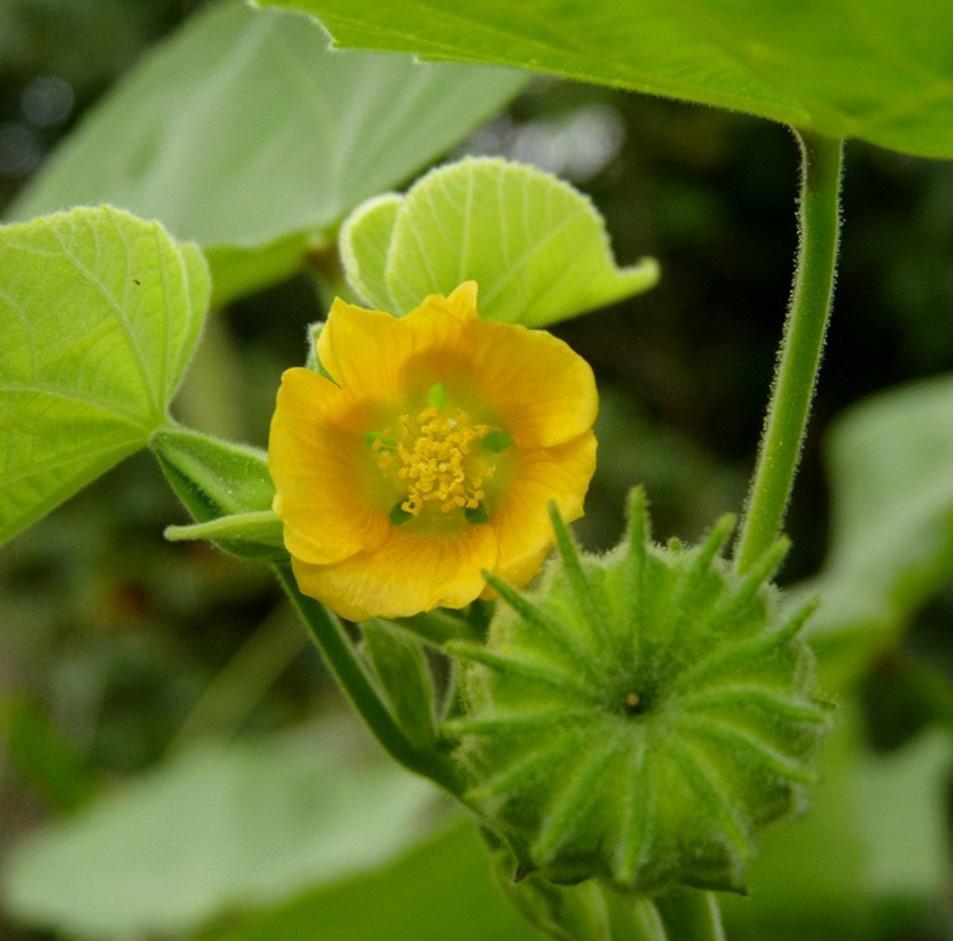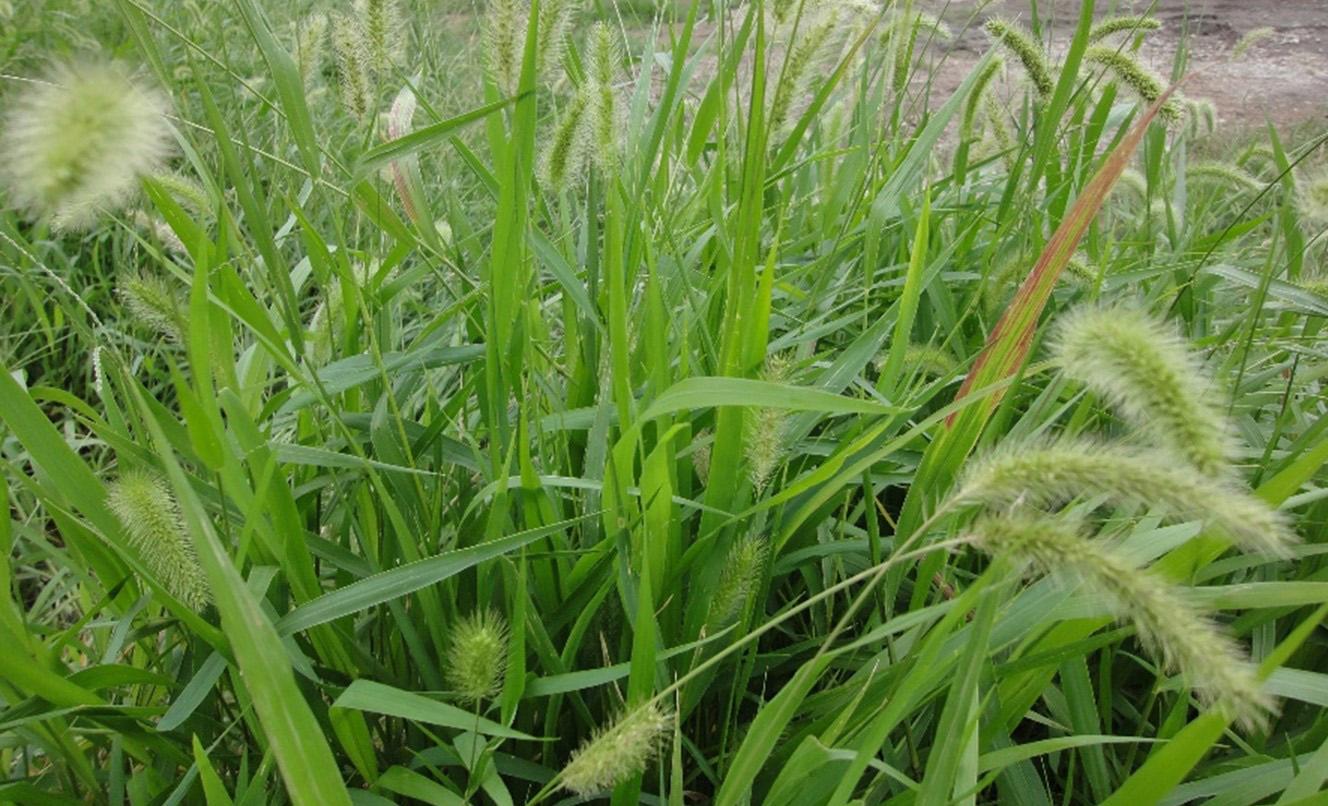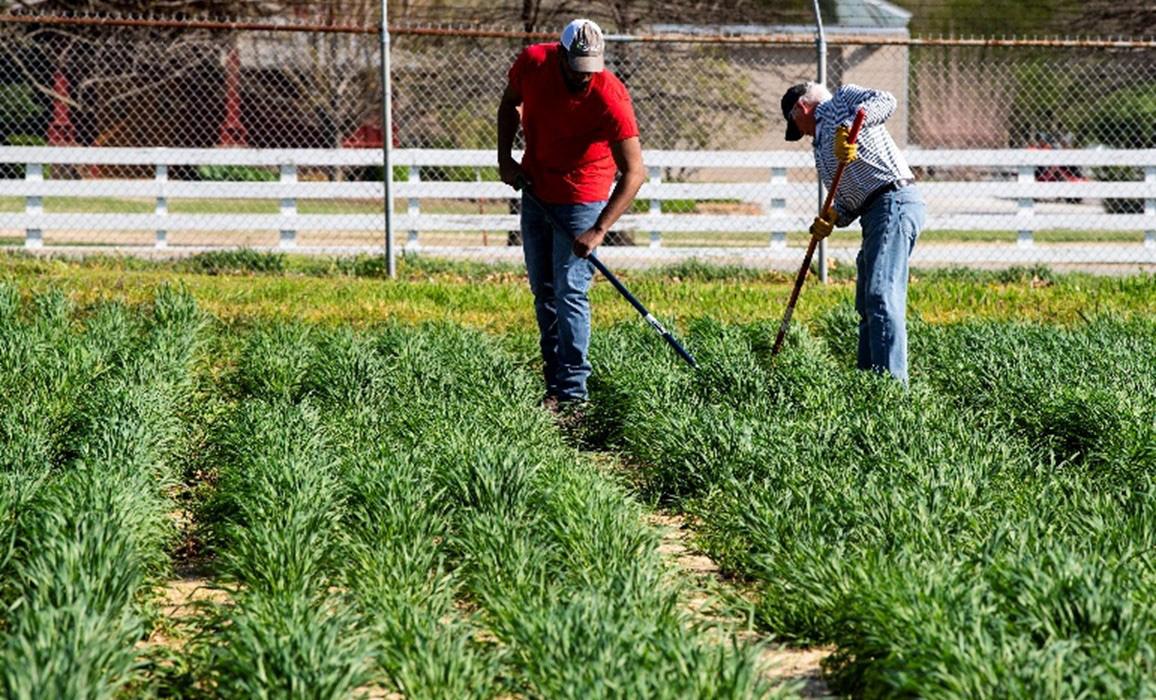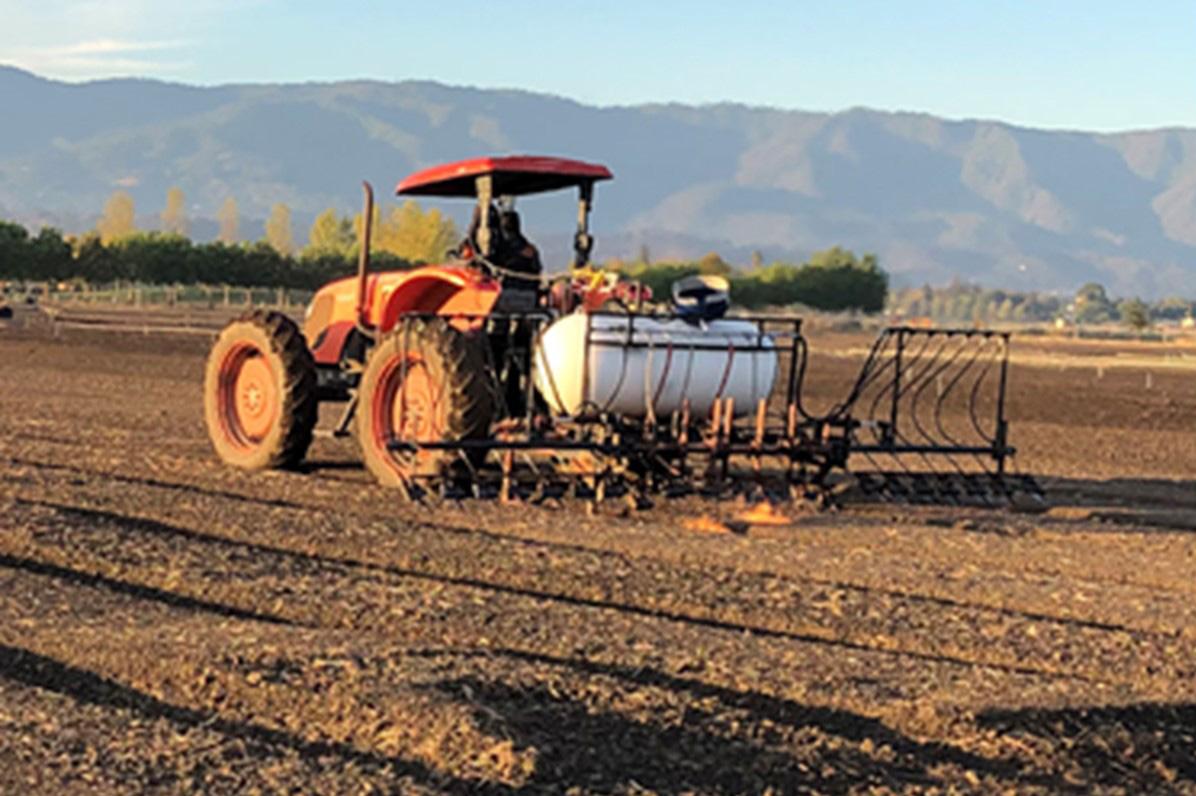Flaming as a Weed Management Tool
Cerruti R Hooks, Professor and Extension Specialist, and Dwayne Joseph, Post-Doctoral Fellow, CMNS, Department of Entomology
Introduction
Mechanical cultivation and hand weeding are organic producers most preferred choices for weed control. However, repeated cultivation has a negative influence on soil structure and organic matter content, and can make conditions more susceptible to soil erosion. In addition, repeated cultivation promotes new weed flushes. On the other hand, hand weeding which may require a ready supply of field workers can be expensive, especially if conducted over large areas and in less competitive crops that require multiple hand weeding tasks. For commercial producers who mostly rely on herbicides, concerns may arise regarding herbicide-resistant weeds, the potential risk to the groundwater supply, and their effect on food quality. This suggests that alternative weed management tools should be considered. Multiple studies have examined effects of flaming on annual weeds; and successful application of propane flaming to manage weeds has been reported in crops such as cotton, field corn, cabbage, carrots, sweet corn and onions. This suggests that weed flaming may be a formidable tactic for incorporation into an integrated weed management (IWM) program. Its successful integration could result in reduced usage of cultivation, hand weeding and herbicide sprays.
Flame weeding or flame cultivation involves using propane burners to create intense heat to manage weeds in the interrow region of row crops or across the whole field in fallow situations. Flame-weeding systems range from handheld flamers for small-scale production to tractor-mounted systems for large-scale, row-crop flaming (Fig. 1). Covers or reflectors used to contain the heat energy close to targeted weeds improve energy efficiency by reducing heat loss. Very brief periods [e.g., 125 millisecond (ms)] of exposures to high temperatures interfere with plant cellular processes such as photosynthesis. Practicing flaming to manage weeds was developed for field crops, fruits and vegetables during the 1940s. However, as interest in low priced herbicides became more prevalent, flaming popularity took a hit. After its almost complete disappearance in the 1970s, flame weeding has regained interest especially in organic production.
How does flaming impact weeds?
Flaming differs from burning in that plant tissues are not incinerated, but rapidly heated causing denaturation and aggregation of cellular proteins. The extent to which heat from the flames penetrates plants depends on the flaming technique and environmental factors such as leaf surface moisture. Denaturation of the plant cells starts at roughly 40°C, depending on exposure time. An increase of temperature above 50°C inside the plant cells can result in the coagulation of membrane proteins leading to loss of membrane integrity. Lethal temperatures are reported to range from 55 to 94°C. Plant cells comprise 95% water; and if plant tissue reaches temperatures above 100°C for a split second, it causes water boiling and cell membrane rupture, resulting in loss of water and plant death. Exposure times in the range of 65–130 ms are sufficient to kill many annuals. Plants may survive flaming by avoidance or heat tolerance. To optimize propane flaming as a weed control tool, the effective dose (ED) of propane required to control targeted weed species must be known. Depending on the desired level of weed control, a propane dose can be used to kill weeds or reduce their competitiveness with crops. For fast-growing crops, pre-emergence flame weeding can provide sufficient weed suppression to allow the formation of full crop canopy, which impedes later weed emergence. In addition to open flame units that target emerged weeds, flames may be directed to the soil surface. Direct heat to the soil surface increases soil temperatures to the weed seed thermal death point. The thermal death point is the temperature at which a seed will not germinate after heat application. Many soil attributes influence the efficacy of direct heat and contribute to variations in treatment efficacy. These include planting depth, soil texture, soil moisture thermal conductivity, soil chemical properties and soil porosity. The efficacy of flaming is determined by the amount of heat transferred from the burner and the duration of time that weeds are exposed to the heat. The amount of heat transferred by the flamer to weeds is determined by the number of burners for a given working width, the nozzle size, and gas pressure; as well as exposure time which is determined by application speed.
What influences the flamer?
Timing
The efficacy of flame weeding is influenced by several factors, including the plant’s growth stage, the physical location of its growing point during flaming, the presence of protective layers of hair or wax and lignification, and the time of day. Multiple studies have shown that plants are more heat sensitive when flamed in the afternoon than early morning. One study compared the effectiveness of flaming at 8 a.m., 12 p.m., 4 p.m., and 8 p.m., and reported better weed control at the noon and 4 p.m., treatment periods. It was suggested that differences in weed control among flaming times could not be explained by differences in temperature, relative humidity or the presence/absence of dew. Thus, in general, it is believed that flaming will be more effective if conducted during the afternoon period. Though, afternoon flaming may result in better weed control; it is important to note that crops are also more vulnerable to injury during this period. Adjusting the angles of torches and positioning the flames below the crop canopy may reduce risk of crop injury during flaming.
Plant type

Weeds susceptibility to flaming varies among species and in general, dicots are more effectively controlled with flaming than monocots. Further, annual weeds are more vulnerable to flame weeding than biennials and perennials. Annual broadleaf and grass species also differ in their response to flaming. Leaves of annual broadleaf species may turn brown and die within a few days after flaming, resulting in no regrowth whereas leaves of grass species may turn white shortly after flaming, leaving an appearance of a dead plant. However, within a week, grass species begin to recover with the growth of new leaves. These varying responses to flaming between broadleaf and grass species are due to the physical positioning of their growing point at the time of flaming. The growing point in grass species during early growth stages is typically below the soil surface and as such, are protected from flames. In contrast, the growing point of broadleaf species is above the ground where it is exposed to the flame. Grasses also have a sheath that protects their growing point. Weeds with unprotected growing points such as lambsquarters have been found to be more sensitive than those with protected growing points such as shepherd's purse (Capsella bursa-pastoris) and that barnyardgrass (Echinochloa crus-galli) and green foxtail (Setaria viridis) are more tolerant to flaming than velvetleaf (Abutilon theophrasti; Fig. 2) and ivyleaf morningglory (Ipomea hederacea). Broadleaf weeds in their vegetative growth stages require propane doses ranging from 30 to 60 kg ha-¹, whereas a vegetative grass such as barnyardgrass can require up to 79 kg ha_¹ to achieve the same level of control. Relative to this, crops in the grass family such as maize and sorghum exhibit higher tolerance to flaming than broadleaf crops such as soybean and sunflower when treated at early growth stages.
Plant growth stage and size
A plant’s tolerance to flaming varies according to its maturity/growth; and developmental stage is probably the most important factor. The growth stage of weeds at the time of flaming helps determine their sensitivity to heat. The growth stage establishes the type and degree of protective layers, the lignification level and location of growing points. Relative to this, flaming is more effective on most weeds at an early growth stage. Smaller plants typically have thinner leaves, lower biomass and fully exposed meristems (not protected by surrounding leaves). In contrast, older seedlings or bigger plants have larger and thicker leaves and greater surface area and biomass, which requires higher temperature and longer exposure to achieve control. Further, they possess larger amounts of food reserves (soluble sugars, proteins and lipids) in stems and roots, providing them with the increased capacity for regrowth. Another critical part of young plants that determines their heat tolerance is the growing point in the shoot apex. In older plants, the shoot apex is often protected by surrounding leaves. The tolerance of different plant parts to flaming can also be influenced by protective layers of hair and/or wax, lignification level and their overall plant water status.

Relative to the growth stage, four weed species [green foxtail (Setaria viridis, Fig. 3), yellow foxtail (Setaria pumila), redroot pigweed (Amaranthus retroflexus) and common waterhemp (Amaranthus rudis)] exhibited more tolerance when flamed at the flowering stage compared with earlier vegetative stages; and popcorn plants flamed at the 2-leaf stage had the highest yield loss. In comparison, flaming popcorn plants at the 5- or 7-leaf stage had less of an effect on ear size. One study found that plant size had a greater influence upon sensitivity to flaming than plant density, with small weeds being more sensitive than large weeds. For example, 42 kg ha−¹ of propane killed 95% of individuals within a solid stand of white mustard plants with 0-2 leaves. However, 74 kg ha−¹ was required to kill 95% containing 2-4 leaves.
Advantage
Flaming can be a viable weed management alternative to hand weeding and cultivation. From an economic standpoint, labor cost associated with hand weeding is more expensive, time-consuming and labor intensive (Fig. 4). Further, flaming can be used when the soil is too moist or stony for hand or mechanical weeding. In comparison with cultivation, flame weeding does not disturb the soil surface or bring buried weed seeds to the surface which makes it compatible with the stale seedbed

technique. Further, in some instances, flaming can be as effective or better than cultivation. A study conducted to compare flaming to mechanical cultivation on weed control in popcorn reported that weed control was better with flaming than cultivation. Moreover, flaming helps reduce concerns regarding direct effects of weed suppression tactics on soil, water, and food quality. For instance, flaming does not leave chemical residues on plants, soil, air or water, and produces no hazardous drifts or chemical carry-over to the next season. Flaming does not contribute to herbicide-tolerant or resistant weeds and weeds are less likely to become resistant to flaming. As such, flaming in some situations is a more feasible alternative to using herbicides or mechanical cultivation.
Disadvantage
The main disadvantages of flame weeding are the lack of residual weed control, the lack of selectivity for crop safety, low speed of application, increased application costs, and applicator safety. The efficacy of flaming may be reduced when environmental conditions such as dew is present. It should also be noted that flaming is not as efficient as chemical control. However, it can be repeated as needed during the growing season and more importantly integrated with other weed management tactics. In addition, postemergence flaming can damage the cash crop. For heat-resistant crops such as cotton, corn, and sugarcane, flames can be directed to the plant’s base during certain growth stages. This technique, is called selective flaming and controls intra-row weeds. For heat-sensitive crops, postemergence flaming can be applied using a covered flamer to help protect crops from the heat. This technique, also known as parallel flaming, controls weeds between the crop rows. Flaming may also be incompatible for conservation tillage and cover cropping as the heavy plant residue that remains on the soil surface may ignite during flaming. Another drawback is that most flame weeding systems are designed to treat a lower number of rows per pass compared to chemical treatments which makes the process slower.
Summary
Flame weeding uses propane burners to generate combustion temperatures of up to 1,900 degrees Celsius, which raises the temperature of exposed weed leaves very rapidly and kills them without burning. Flaming in the absence of killing weeds can severely reduce their growth, thereby making them less competitive with crops. Weeds and other plants' susceptibility to flaming will vary according to species, plant size and growth stage during flaming. Broadleaves are generally more sensitive than grasses, and older and larger plants require higher energy rates for control than younger and/or smaller plants with fewer leaves. Flaming before crop emergence has been the predominant thermal weed control method in slow-germinating row crops such as onion, leek, carrot and corn. However, preemergence flaming may be of limited value in fast emerging crops because the crop may easily emerge before most weeds. As such, preemergence flaming would only control a fraction of the weeds that will emerge during the cropping season. Still, flaming has shown good results after weed emergence and before crop emergence in crops such as potato, sugar beet, carrot and cayenne pepper. When conducted postemergence, vulnerable crops such as soybean and sunflower must be protected from flaming. Other crops such as corn and sorghum have some tolerance to flaming. Flaming similar to other weed management tactics should not be viewed as a stand-alone tactic. However, it can be successfully incorporated into an IWM plan and thus be used in concert with other tools. For example, weeds in corn were controlled through integration of tillage and flaming. Financial support for the publication of this article is via USDA NIFA EIPM grant award numbers 2021-70006-35384 and NESARE - Research for Novel Approaches (LNE20-406R).
This article appears in the June 2022, Volume 13, Issue 3 of the Vegetable and Fruit News
